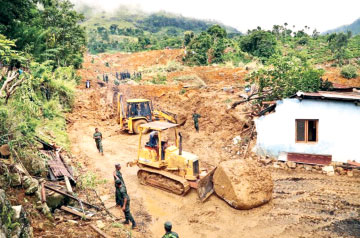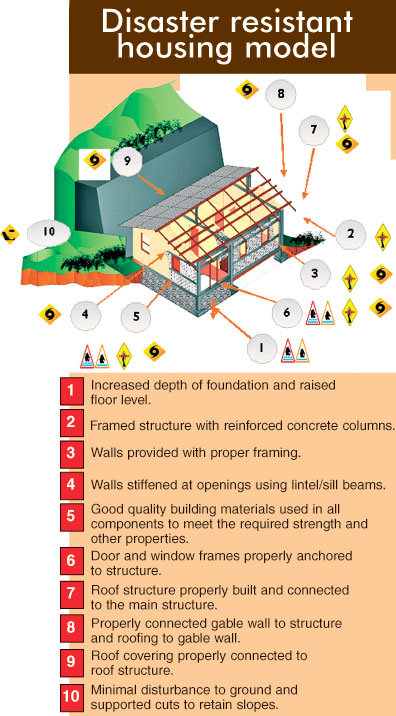|
Disaster management is not about emergency relief but
about:
Being prepared
by Dhaneshi Yatawara
The continuing nightmare that is Meeriyabedda and the vulnerability
of Sri Lanka to the perils of floods, tornadoes and other natural
disasters has brought into sharp focus the need to invest in disaster
preparedness rather than spending on emergency relief.

Meeriyabedda landslide |
 |
| Koslanda
landslide |
 |
Wasantha Senadeera, Project officer for the Coordinating
Secretariat for Science, Technology and Innovation (COSTI)
expressed serious concern over climate change world over and Sri
Lanka in perticular.
|
 |
|
Project officer Nilanka Karunaratne said discussions were
on-going to bring in pre-built houses to disaster affected areas
in the hill country’ where a house is constructed quickly and it
is just a matter of assembling pre- fixed parts of the house. |
Dr. Ananda Mallawatantri, a veteran in disaster management
aknowledging that natural disasters could become more frequent in the
future echoed the need for the shift in investment focus. Describing
disaster management as a complicated subject requires knowledge on
climate, geology, agriculture and many other fields he said the
management should have a holistic approach supported by state- of-
the-art knowledge.
Being involved in programming several disaster management and
mitigating techniques, Dr. Mallawathantri is of the view that if a
conducive environment is created to discuss these matters, all
stakeholders would work together to create a safe environment. “We have
to overcome the fragmentation currently faced by disaster management
agencies,” he said.
“Although Sri Lanka has a solid foundation of knowledge on the nature
of disasters and mitigation, we still do not feel that it is
comprehensive enough to find a solution. Why has this foundation not
gone to the level where the real work is happening?” he queried. He
adduced multiple reasons for this situation.. “We need to get all
stakeholders involved in to the project. For example following the
Northern Environment Strategic Assessment the Urban Development
Authority immediately adopted it, the Forest Department declared
protected zones and the Archaeological Department declared their zones
immediately because they were part of the project and were able to
implement the collective agreement,” explained Mallawathantri.
He said government institutions getting caught or pushed into
unrealistic targets can lead to disaster as well. When this happens,
officials only think of completing the project, and put aside other
requirements. When the focus is only on the end product, disaster
mitigation and construction resilience is overlooked. These decisions
could promote disaster and we have plenty of examples in Sri Lanka to
learn. If adequate space can be given for the science to come in, while
giving similar concern to the end product, much of the disaster could be
avoided,” he elaborated.
Meeriyabedde landslide
The Meeriyabedde landslide is a case in point. How can such
situations be overcome or at least be made known to the public with
early warning signs? Wasantha Senadeera, Project officer for the
Coordinating Secretariat for Science, Technology and Innovation (COSTI)
expressed serious concern over climate change world over and Sri Lanka
in perticular.
Climate change is a global phenomenon and is now taking its toll in
Sri Lanka as well. Strange weather patterns, frequent landslides and
floods, drought in certain parts of the country are some of the changes
affecting Sri Lanka.
Decades ago,. natural disaster did take place in other countries and
in Sri Lanka but not on such an unprecedented scale as today. Experts
blame it on unplanned human activity.
“Preparing for earthquakes, tsunamis, cyclones and tornadoes is now
on every government’s agenda, not only to minimise casualties but also
monitor such disasters, which are being reported”, in the aftermath of
the Nepal earthquake, geologists around the world were seriously
concerned as to why these disasters occurred and measured the magnitude
of the damage.
However, many of them blamed it solely on irresponsible human
activity. Senadeera said, adding “There were unavoidable instances when
a natural disaster takes its toll and can be attributed to a sudden
change in either the weather pattern or in geographical changes but such
cases do not happen so frequently”.
COSTI coordinates institutes and line ministries to implement
automated early warning systems innovated by scientists of Sri Lankan
universities. “Authorities need to be better equipped to face the global
truth and efficient disaster detection and alerting system could reduce
the loss of life and property” Senadeera said. When asked whether Sri
Lanka could cope with a grave situation like what happened in Nepal,
Senadeera was quick to respond. In Sri Lanka, technology is widely used
for early warnings, response and mitigation in the Emergency Operation
Centre of the Disaster Management Centre - equipped with high- tech
instruments for early warning dissemination and response activities.To
rise to such a situation, COSTI is putting an effort to coordinate and
convince authorities to implement automated early-warning systems
addressing near real-time detection of meteorological natural hazards in
Sri Lanka.
 This includes Unmanned Air Vehicles (UAVs), under water vehicles, met
buoys for coastal areas, Automated flood indicators, sensor columns for
landslides and water quality sondes for rivers and major water ways
which is an advanced water quality monitoring device that can be
integrated into marine, estuarine, freshwater and ground water
monitoring systems,” he said. This includes Unmanned Air Vehicles (UAVs), under water vehicles, met
buoys for coastal areas, Automated flood indicators, sensor columns for
landslides and water quality sondes for rivers and major water ways
which is an advanced water quality monitoring device that can be
integrated into marine, estuarine, freshwater and ground water
monitoring systems,” he said.
“We worked closely with the University of Moratuwa, expert civil
engineers and architects to bring these innovations on to a single
platform,” Senadeera said, adding that in an effort to assist the
programs to resettle victims, COSTI has a few projects to bring in quick
housing solutions’, he said.
Talking of the most promising project, project officer Nilanka
Karunaratne said discussions were on-going to bring in pre-built houses
to disaster affected areas in the hill country’ where a house is
constructed quickly and it is just a matter of assembling pre- fixed
parts of the house. Resettling disaster- affected communities is of
paramount importance as poverty and disaster form a vicious cycle in Sri
Lanka. “Prior planning is essential when resettling! A rapid housing
system is proposed and discussions were proceeding to get funding and
technical know-how from a New Zealand company. These are pre-prepared
building and it is just a matter of assembling the parts,” she added.
Following the killer waves of the 2004 tsunami, a roadmap was
designed towards a safer Sri Lanka. Being a developing country policies
and well- organised disaster management system is of great importance.
The Disaster Management Centre (DMC) of Sri Lanka and National
Building Research Organisation (NBRO) said that disaster and risk
management compared to the past six to seven years, were at a
satisfactory level and could be handled much better than it was earlier.
Apart from grave issues like tsunamis, these organisations are
concerned about the cyclonic situation and floods in the country that
could eventually cause landslides. Especially in the areas along the
Kelani River, Gin Ganga and Kalu Ganga these measures had been taken
where spill levels of the rivers are marked as a warning and safety
areas are indicated.
The DMC had identified 14 districts that have landslide risks
countrywide and have linked up with the NBRO to educate residents in
respective areas to act in an emergency.
Wrong construction practices
“Wrong construction practices is one of the main causes for
landslides and earthslips”, she said. When people dig mountainous areas
and build structures, leaving huge mounds of soil unsupported, obviously
these will come crashing down at some point of time,” she said.
The NBRO has identified 10 districts with landslide hazards which are
Kandy, Matale, Nuwara Eliya, Kegalle, Ratnapura, Kalutara, Badulla,
Matara, Galle and Hambantota.
Following a three- year study, the NBRO has prepared a construction
manual to guide constructions in slopes and mountains. These guidelines
are based on research and studies done by experts from the Universities
of Peradeniya and Moratuwa..
“This is to address unskilled construction workers, who have no
engineering skills” said
Krishantha Sugathapala, Director, Human Settlement Planning and
Training Division of the NBRO.
According to the study, more than 80% of the housing projects are
based on non-engineering skills. “Contractors constructing large scale
buildings are aware of the techniques in disaster mitigation and their
contracts include costs involved. But the carpenter and mason build
based on traditional knowledge which does not include disaster
mitigating techniques. And this is to help such people,” said
Sugathapala. |

